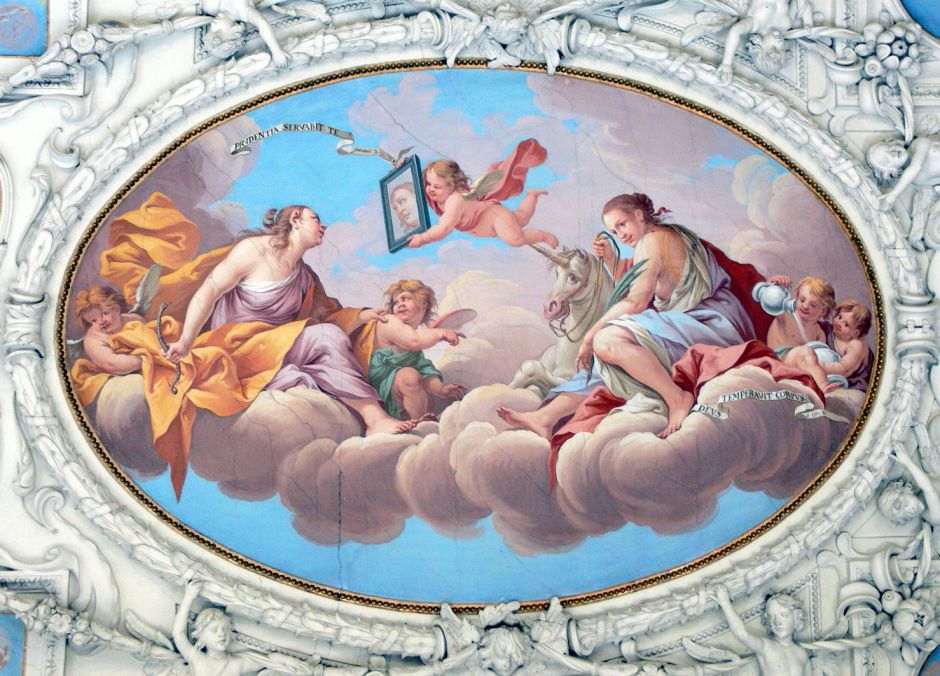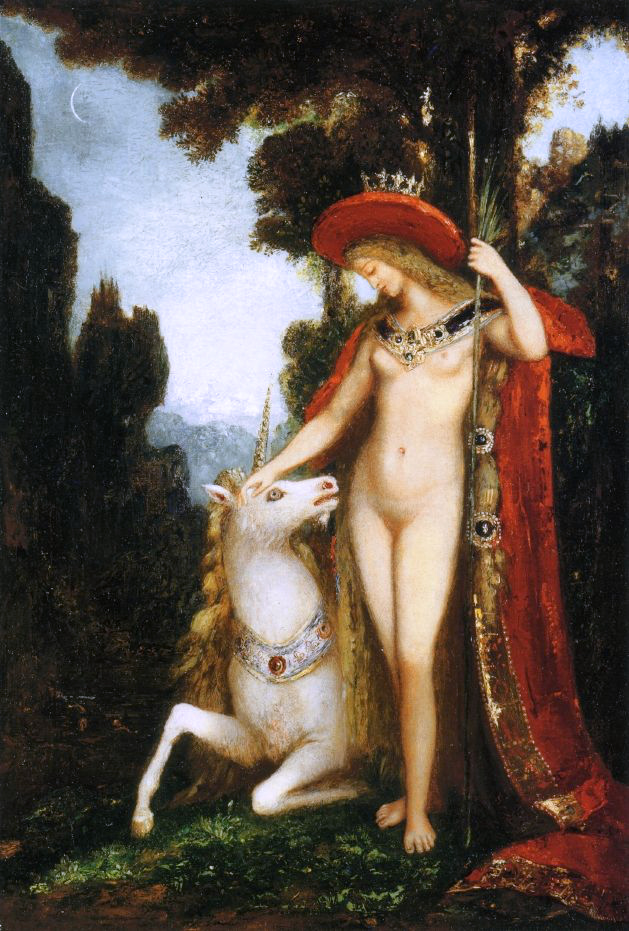In yesterday’s article, I showed examples of early modern visual art in which unicorns featured, up to the middle of the sixteenth century. That was a period in which most well-educated people believed that unicorns actually existed, as had been recorded since the first natural histories were written by the ancient Greeks. It was still unusual for unicorns to appear among the imaginary animals typical of mythology.
When Ariosto assembled his menagerie of hippogriffs, orcs and other fictional creatures in his epic poem Orlando Furioso, he included a cameo appearance of white unicorns in one scene.

Niccolò dell’Abbate’s fresco in the Palazzo Torfanini in Bologna, Italy, shows Ruggiero and a companion arriving at the gate of an enchanted city mounted on those unicorns. This was painted in about 1550, around the time that Tintoretto and his workshop in Venice were working on the painting below.

In the Creation of the Animals, the first of his Old Testament cycle for the Scuola della Trinità, God flies along as he is creating pairs of different species of bird, fish, and animal, from cormorants to rabbits. At the upper right corner is the unmistakable head of a white unicorn, suggesting that Tintoretto also believed that they were real rather than legendary.

François Clouet’s rather risqué Lady in Her Bath from about 1571 uses a fireguard as a painting within a painting to send what might seem a curious message. Next to the rather demure woman in her bath is a wet nurse feeding the second child of this affluent family. Behind the maidservant in the distance is a fireguard on which there’s a white unicorn. In this case, given the lady’s two children, it must signify not chastity but faithfulness.

Others still appear convinced that, somewhere on earth, wild unicorns were to be found. Maerten de Vos may have based this portrait of a Unicorn (1572) on travellers’ tales from those who had returned from Africa, judging by the appearance of the locals in the background.

Domenichino’s fresco of a Virgin and Unicorn from about 1602, which he painted in the Palazzo Farnese in Ponte, Italy, shows the standard legend of a virgin taming a wild white unicorn. This too is alleged to show Giulia Farnese, mistress of Pope Alexander VI, although she had died about eighty years earlier. He painted this when working under the direction of Annibale Carracci, who died a few years later.

Jan Brueghel the Younger seems to have become quite imaginative when painting the Creation of Adam in Paradise. He includes a strange-looking giraffe and a brilliant white unicorn in the distance, together with many real creatures.
For me, the most surprising painting of all was made by the great animal artist Paulus Potter, who is best-known for his faithful depictions of livestock.

Potter’s Orpheus and Animals from 1650 shows a wide range of different animal species, some of which were still not well-known at the time. These include a Bactrian camel (two humps), donkey, cattle, ox, wild pig, sheep, dog, goat, rabbit, lions, dromedary (one hump), horse, elephant, snake, deer, lizard, wolf, monkey and unicorn.

Carpoforo Tencalla’s splendid fresco in the Schloss Trautenfels in Steiermark, Austria, shows Allegories of Prudence and Temperance (1670-73). Prudence is on the left, examining herself in the mirror whilst holding a snake in her right hand. Temperance, on the right, sits next to a white unicorn, here reflecting her chastity.
By the late seventeenth century, the unicorn had been thoroughly debunked and vanished from paintings until its return in Symbolism.

In the mid 1880s, Gustave Moreau revived the unicorn as a symbol of chastity when retelling its legendary existence. The Unicorn (1884-85) reveals those rich symbolic associations as Moreau repeatedly painted a single unicorn being fondled by an almost nude woman, alluding to the expansive complex of mediaeval myths which associate the animal with a virgin or the Virgin, who seem to be the only humans capable of trapping a unicorn.

Unicorn (1885) is a slightly later variant, probably executed in watercolour.

The Unicorns from about 1885-90, shows no less than three unicorns being fondled and petted by an incongruously nude woman and several others, who are wearing elborate decorated robes. In the right foreground is a crystal chalice, which may be a reference to one of the complex of grail legends.

The unicorn continues to appear in more modern paintings of fantasy worlds, such as that of the American artist Arthur Bowen Davies. This is probably his most famous painting, Unicorns (Legend—Sea Calm), which he completed in 1906. It appears strongly influenced by the European Symbolist movement of the late nineteenth century.
Even if it never really existed, the unicorn still isn’t dead. Not by a long way.

